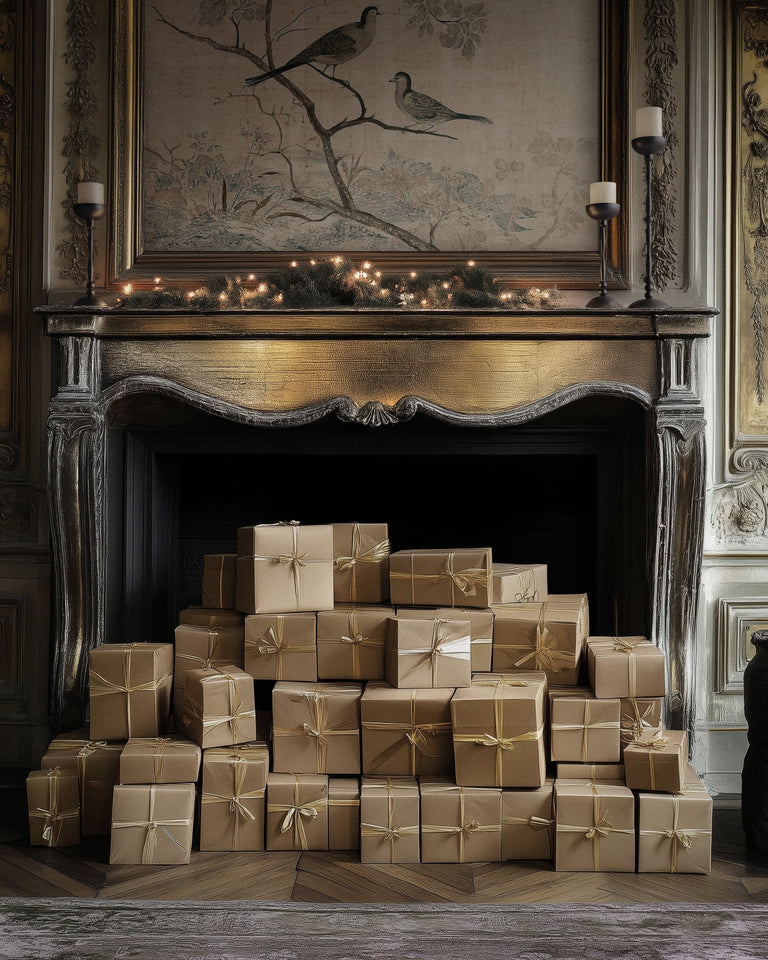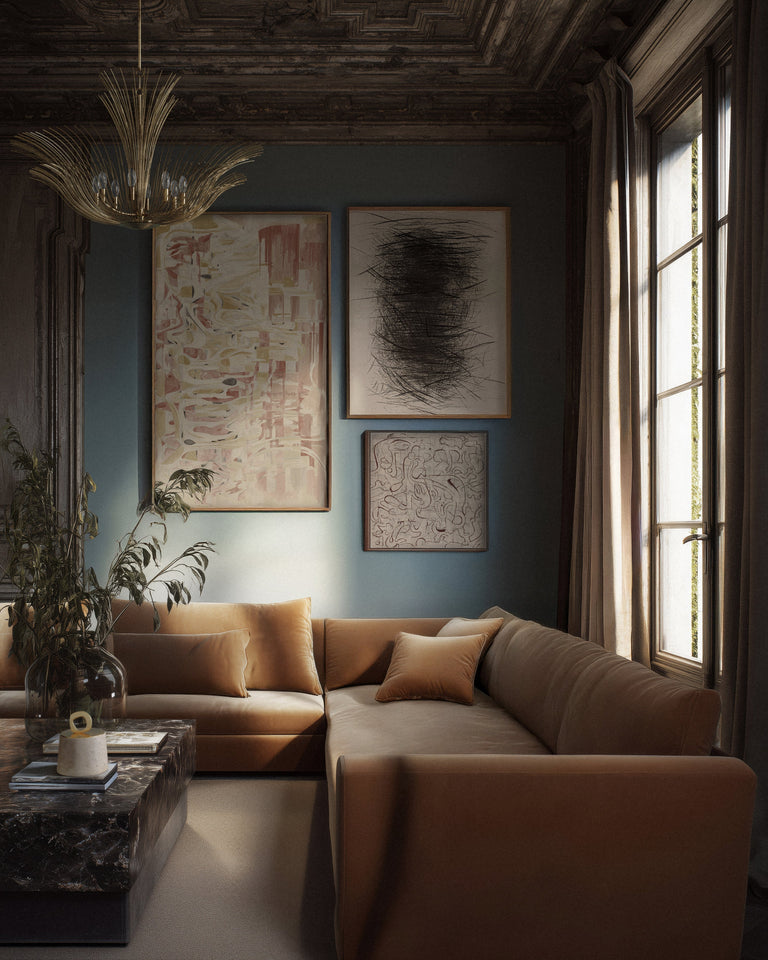
Outside In: Nature Imprint on Form
This season, we return to the language of form. Plaster, with its chalky texture and ancient resonance, anchors our most sculptural works—an elemental material once favored by Brancusi, Arp, and Giacometti, reimagined here for the interior.
Where Nature Meets Human Vision
In the legendary ateliers of Montparnasse, where the greatest sculptors of the 20th century worked through the revolutionary years of modern art, a profound dialogue was taking place between human creativity and natural form. These sacred spaces, Constantin Brancusi's workshop with its forest of gleaming bronze and marble, Jean Arp's studio filled with organic abstractions, Alberto Giacometti's cramped quarters dense with figures emerging from and dissolving back into raw material, were laboratories of observation where artists spent decades decoding the essential languages of natural beauty.
These masters understood what contemporary science has only recently confirmed: that the forms found in nature operate according to mathematical principles that human beings find inherently pleasing. The golden ratio spiraling through a nautilus shell, the fractal branching of tree structures, the flowing curves of water-worn stones, expressions of fundamental organizing principles that could be distilled, abstracted, and reimagined for human habitation.

Courtesy of Centre Pompidou
Brancusi's Sacred Geometry: Finding the Essential in the Organic
Constantin Brancusi's atelier on the Impasse Ronsin was perhaps the most legendary workspace in the history of modern art, a cathedral of form where the Romanian master spent decades pursuing what he called "the essence of things." Visitors described entering a space that felt simultaneously ancient and utterly contemporary, filled with gleaming birds that seemed ready for flight, endless columns that reached toward infinity, and ovoid forms that captured the very DNA of natural growth.
Brancusi's obsession was nature's hidden geometry. He studied eggs for their perfect ovoid proportions, observed birds not just in flight but in stillness, seeking the essential form that contained both movement and rest. He upheld the governing philosophy of an entire generation of artists who understood that nature's deepest lessons lay not in surface appearance but in underlying structural principles.
Giacometti's Existential Landscapes: Form as Living Presence
Alberto Giacometti's cramped studio on the rue Hippolyte-Maindron represented yet another approach to nature's lessons, one focused on presence, atmosphere, and the way living forms assert themselves in space. His working method was perhaps the most physically intense of the three masters, involving endless sessions of building up and scraping away, seeking forms that could embody the essential mystery of animate existence.
Giacometti's relationship with plaster was deeply physical and emotional. He described the material as responsive to the slightest touch, capable of recording not just deliberate marks but the unconscious gestures that revealed an artist's true relationship with their subject. His figures emerged from marathon sessions where he would work for hours without rest, building up surfaces only to scrape them away, pursuing forms that could capture what he called "the sensation of life."
The surfaces of Giacometti's plaster works carried a record of this intense process: rough, immediate, bearing the evidence of countless decisions and revisions. Yet this apparent crudeness achieved something that polished perfection could not: a sense of genuine life force, of forms that seemed to breathe and pulse with the same energy that drives natural growth and decay.
The Science of Natural Form: What the Masters Intuited
Contemporary research in environmental psychology and cognitive science has confirmed what these master sculptors understood intuitively: human beings possess deep-seated preferences for certain proportions, curves, and spatial relationships that correspond directly to patterns found in natural environments.

Material Honesty: Plaster as Nature's Collaborator
What made plaster the perfect medium for these explorations was its fundamental honesty, its capacity to record every gesture while remaining endlessly workable, its ability to achieve both delicate detail and monumental presence, its natural affinity for the kind of surface variation that makes handcrafted objects so much more compelling than machine-made alternatives.
Plaster, formed from natural gypsum through fire and water, maintains an essential connection to earth processes that synthetic materials cannot replicate. Its slightly chalky texture invites touch while its subtle surface variations catch and hold light in ways that feel alive and responsive.
The Contemporary Atelier
Today's finest sculptural objects continue this tradition of learning from nature's formal vocabulary while serving the practical needs of contemporary interior spaces. The challenge lies in translating the insights gleaned in artists' ateliers into objects that can organize and elevate the spaces where we actually live.
This requires understanding how natural proportions work at different scales, how organic curves can create visual flow through interior spaces, how the subtle surface variations that characterize handcrafted objects can provide the kind of sensory richness that makes spaces feel genuinely comfortable rather than merely visually appealing.
How Natural Illumination Awakens Form
Natural light doesn't simply illuminate sculptural objects; it collaborates with them, revealing surfaces and proportions that remain hidden under artificial illumination. The subtle texture variations that characterize plaster surfaces create micro-landscapes of shadow and highlight that change throughout the day, keeping spaces visually alive and connected to natural rhythms.
This temporal dimension adds layers of meaning that purely synthetic materials cannot achieve. Like natural forms that reveal different characteristics under different lighting conditions—tree bark that glows silver in morning light, stone that warms to gold in evening sun—the finest plaster objects maintain their essential character while offering constant visual discovery.
The Enduring Lessons: Form as Universal Language
What unites the greatest sculptural works across cultures and centuries is their understanding of form as a universal language that speaks directly to human consciousness without requiring cultural translation. The curves that Brancusi discovered in eggs appear also in ancient pottery, in contemporary architecture, in the shells that wash up on every beach. These aren't mere aesthetic preferences but expressions of fundamental organizing principles that govern both natural and human creativity.
By working within this universal vocabulary while addressing the specific needs of contemporary living, the finest sculptural objects create bridges between past and present, between natural and human order, between the insights gleaned in artists' ateliers and the practical requirements of daily life.

Our Collection: Nature's Geometry Reimagined for Interior Spaces
Our collection of plaster and light-toned ceramic décor pays homage to this rich tradition while addressing the unique requirements of contemporary interior design. Each piece embodies the lessons learned in legendary ateliers—the understanding that the most powerful sculptural forms are those that capture nature's essential organizing principles rather than copying its surface characteristics.
The Souple Console evokes the sensual minimalism that Brancusi achieved in his ovoid forms, its flowing lines creating the kind of visual movement that characterizes living growth.
Carmen, a pierced totem, balances void and mass in the lyrical proportions that Arp discovered in his organic abstractions.
Lucien and Baron stand as contemporary interpretations of Giacometti's exploration of presence and space, where geometry, light, and rhythm converge to create objects that feel simultaneously monumental and graceful.
The Imane Organic Sculpture captures movement mid-gesture, embodying the kind of dynamic energy that the masters found in natural growth patterns.
The Victoire Vase, with its fluted edge and matte finish, feels excavated rather than made, carrying that sense of natural discovery that characterizes the finest handcrafted objects.
The Amorphous Mirror offers a softened reflection that echoes the irregular beauty of water surfaces, while The Amorphous Organic Hurricanes cast shadows like sculpture under flame.
These pieces achieve what the masters pursued in their legendary ateliers: solidity without heaviness, minimalism with soul.
Discover how the formal vocabulary developed in legendary artists' ateliers can transform contemporary interior spaces through our collection of sculptural plaster and ceramic objects, pieces that bridge the gap between natural beauty and refined living.
Recent Edits








